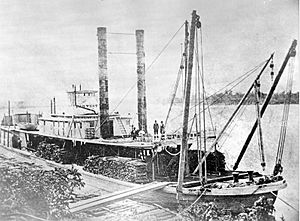Far West (steamship) facts for kids
The Far West was a special type of steamboat called a sternwheel paddle steamer. It traveled on the Missouri and Yellowstone Rivers in the Dakota and Montana areas from 1870 to 1883. This famous riverboat played a big part in the Indian Wars of the American West. It became a symbol of how important steamboats were for transport before railroads took over.
The Far West was known for being light, strong, and very fast. It was first owned by the Coulson Packet Line, which worked with the United States Army to help their expeditions. The boat was often steered by a famous captain named Grant Marsh. Its powerful engines, sleek design, and low shape made it super speedy. It even set several speed records on the Missouri and Yellowstone rivers!
Contents
Building the Far West
The Far West was built in Pittsburgh in 1870. It was 190 ft (58 m) long and 33 ft (10 m) wide. The boat had three decks and two tall smokestacks. When it was empty, it only needed 20 in (51 cm) of water to float. Even when fully loaded with 200 tons of cargo, it only needed 30 in (76 cm) of water.
Engines and Power
The Far West had two strong steam engines built in Brownsville, Pennsylvania. These engines got their power from three boilers that burned a lot of wood—up to 30 cords a day! The engines turned a huge 30-foot-wide (9.1 m) paddlewheel at the back of the boat.
Special Features
The Far West was one of the first boats with two steam winches (called capstans) at the front. These were used for a special trick called "grasshopping." This trick helped the boat get over shallow sandbars by lifting and swinging itself forward a few feet at a time. This made it famous for being able to travel through shallow parts of the rivers where other boats couldn't go.
The Far West in the Great Sioux War
The Far West became very important during the Great Sioux War of 1876. The United States Army hired it to support a large military group led by General Alfred Terry and Lt. Colonel George Armstrong Custer. This group was looking for a big camp of Sioux and Cheyenne people.
Supplying the Army
The Far West brought supplies to the soldiers as they moved up the Yellowstone River. General Terry even used the boat as his headquarters. On June 21, 1876, a very important meeting happened on the Far West. Here, officers planned the next steps, which led to Custer and his 7th Cavalry riding off to find the Native American villages.
The Battle of the Little Bighorn
Just a few days later, on June 25, 1876, Custer and his soldiers faced a terrible defeat at the Battle of the Little Bighorn. Many soldiers were killed or wounded. The Far West then traveled up the Bighorn River to the mouth of the Little Bighorn.
A Hospital Ship
Captain Grant Marsh quickly turned the Far West into a hospital ship. Grass and canvas were laid on the decks to make beds for the wounded soldiers. On June 30, 1876, 52 wounded soldiers were carefully brought on board.
Record-Breaking Journey
On July 3, General Terry ordered the Far West to take the wounded to Bismarck, Dakota Territory, which was 710 mi (1,140 km) away downriver. Captain Marsh and his crew traveled day and night without stopping much. The Far West reached Bismarck in an amazing 54 hours, setting a new speed record for riverboat travel!
This fast trip brought the first news of Custer's defeat, which became known as the "Custer Massacre." The news was sent by telegraph across the country, shocking everyone during the July 4th celebrations.
Later Years and Sinking
After 1876, the Far West was sold to new owners. It kept carrying goods and people on the Missouri and Yellowstone rivers and continued to set speed records. In 1881, it was the first boat to reach Fort Benton, Montana, that year, even though the river was very high.
Sadly, in October 1883, the Far West hit a hidden log (called a snag) in the Missouri River near St. Charles, Missouri. The damage was too great, and the famous steamboat sank.


